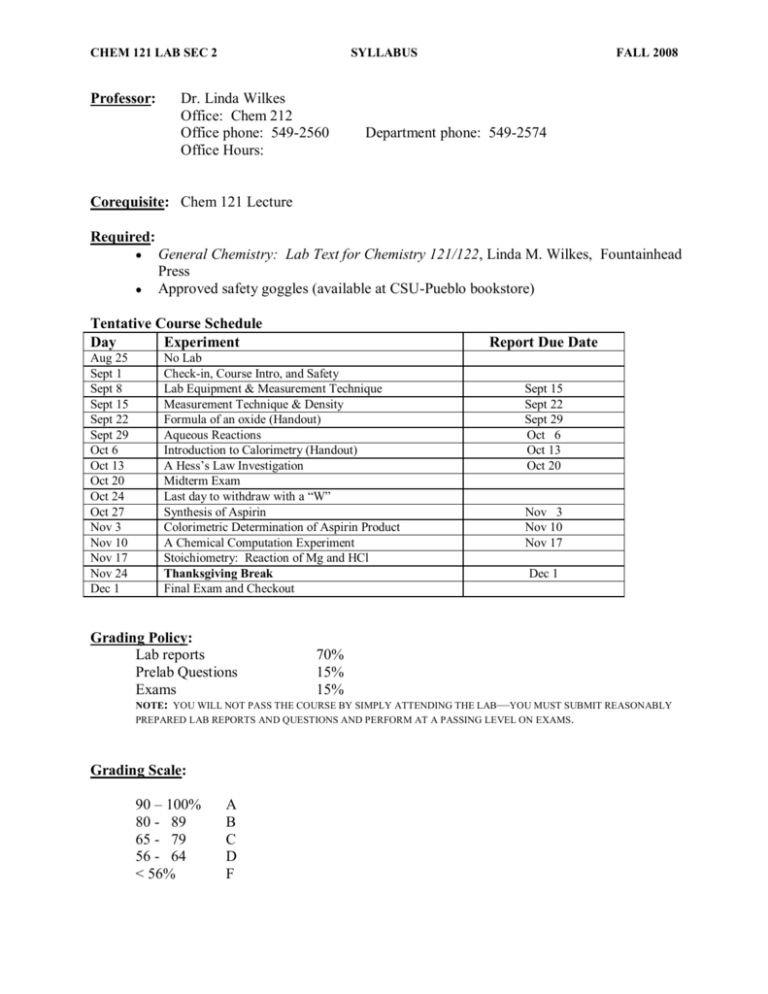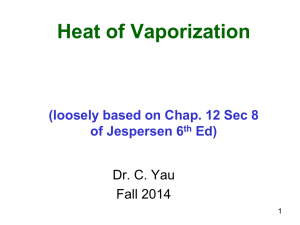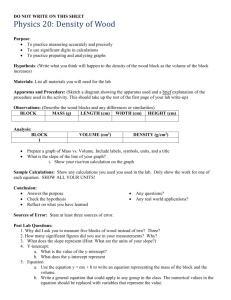sample lab report - Colorado State University
advertisement

CHEM 121 LAB SEC 2 Professor: SYLLABUS Dr. Linda Wilkes Office: Chem 212 Office phone: 549-2560 Office Hours: FALL 2008 Department phone: 549-2574 Corequisite: Chem 121 Lecture Required: General Chemistry: Lab Text for Chemistry 121/122, Linda M. Wilkes, Fountainhead Press Approved safety goggles (available at CSU-Pueblo bookstore) Tentative Course Schedule Day Experiment Aug 25 Sept 1 Sept 8 Sept 15 Sept 22 Sept 29 Oct 6 Oct 13 Oct 20 Oct 24 Oct 27 Nov 3 Nov 10 Nov 17 Nov 24 Dec 1 Report Due Date No Lab Check-in, Course Intro, and Safety Lab Equipment & Measurement Technique Measurement Technique & Density Formula of an oxide (Handout) Aqueous Reactions Introduction to Calorimetry (Handout) A Hess‘s Law Investigation Midterm Exam Last day to withdraw with a ―W‖ Synthesis of Aspirin Colorimetric Determination of Aspirin Product A Chemical Computation Experiment Stoichiometry: Reaction of Mg and HCl Thanksgiving Break Final Exam and Checkout Grading Policy: Lab reports Prelab Questions Exams Sept 15 Sept 22 Sept 29 Oct 6 Oct 13 Oct 20 Nov 3 Nov 10 Nov 17 Dec 1 70% 15% 15% NOTE: YOU WILL NOT PASS THE COURSE BY SIMPLY ATTENDING THE LAB—YOU MUST SUBMIT REASONABLY PREPARED LAB REPORTS AND QUESTIONS AND PERFORM AT A PASSING LEVEL ON EXAMS. Grading Scale: 90 – 100% 80 - 89 65 - 79 56 - 64 < 56% A B C D F CHEM 121 LAB SEC 2 SYLLABUS FALL 2008 Policies: 1. Lab reports are due one week following completion of the lab ( SEE ATTACHED DOCUMENTATION ON THE REQUIRED FORMAT OF LAB REPORTS). 2. Prelab questions for each lab experiment are due the day the lab experiment is to be performed at the beginning of the lab period. 3. Late labs will be deducted 25% off per day late for one day only (no reports will be accepted later than Friday, 2 pm of the week the lab report is due). 4. No makeup labs are allowed, the one, lowest lab report score is dropped and a missed lab experiment counts as a zero for that lab report. 5. The Colorado State University-Pueblo Catalog has a section on Academic Dishonesty on page 38. You should review the official university position on issues of conduct in the Student Code of Conduct Policies and Procedures Manual. Scientific honesty is particularly important in experimental work, i.e., in a field such as chemistry. The scientific body of knowledge on which the advancement of our civilization is based would not have been possible without the rigid integrity of the scientific observations that are its foundation. Your personal integrity is worth more than a few points on an exam. Cheating will be grounds for failure of the course. 6. This University abides by the Americans with Disabilities Act and Section 504 of the Rehabilitation Act of 1973, which stipulates that no student shall be denied the benefits of an education ―solely by reason of a handicap.‖ If you have a documented disability that may impact your work in this class and for which you may require accommodations, please see the Disability Resource Coordinator as soon as possible to arrange accommodations. In order to receive accommodations, you must be registered with and provide documentation of your disability to: the Disability Resource Office, which is located in the Psychology Building, Suite 232. 7. Should you decide not to complete the course, you must withdraw before Oct. 24, 5 pm in the Records office in order to receive a ‗W‘ on your transcript. CHEM 121 LAB SEC 2 SYLLABUS FALL 2008 CHEMISTRY 121/122 Requirements for Lab Reports The main reason for the Lab Report is to show your instructor that you understand the experiment and can report on and make sense of your data. To that end, a Lab Report should include: I. II. III. IV. V. A paragraph summarizing the objectives and concepts of the experiment—pretend that you are explaining the experiment to your roommate who has not taken any chemistry! o This is NOT COPIED DIRECTLY FROM THE LABORATORY EXPERIMENT TEXT! It is a compilation of information written in your own words (grammatically correct!) and it should have multiple sources: (1) your instructor’s lecture; (2) your chemistry text; (3) your laboratory experiment text. All data collected—make sure all data is labeled—if it is not labeled, it is not submitted. Your data may be submitted directly by using the tear-out data sheets from your lab text (make sure they are neat and readable!). All calculations, shown clearly! The calculations can generally be on the data sheets with your data, however, if there is not enough room, you may need to submit an extra sheet of calculations. o The calculations should be organized such that they are easy to follow, show all steps of the calculations. A paragraph summarizing your results must be included; both qualitative results (observations) as well as quantitative results (numerical). o In addition, you should analyze your results in this paragraph. For example, in one experiment you produced several different graphs by plotting some data in different forms. Some graphs were linear, some were non-linear. In your results you state which graphs were linear and which were non-linear. In your analysis or discussion of your results, you discuss why a linear relationship in the data is important and what it tells you about your data if the graph is linear and if the graph is non-linear. All calculations/answers to any post-lab questions, these may be submitted by using the tear-out post-lab questions in the lab text. CHEM 121 LAB SEC 2 SYLLABUS FALL 2008 SAMPLE LAB REPORT Vapor Pressure of Water Part I: Introduction (244 words) The purpose of this experiment is to determine the molar heat of vaporization of water ( Hvap) using the Clausius-Clapeyron a The purpose and concept used is clearly stated. Note that the text book is referenced as being a source of information equation:a (Chapter 11, Brown and LeMay) ln P H vap RT A b b where P is the vapor pressure of water and T is the temperature of the water in Kelvin, R is a Any mathematical equations or chemical equations that describe the experiment should be clearly given—not in a text line, but on a separate line—with symbols defined the gas constant (8.314 J/mol K) and A is a constant. The Clausius-Clapeyron equation exhibits a relationship between the natural log of the vapor pressure (ln P) of a liquid and the reciprocal of the temperature (1/T) such that by plotting ln P (y-axis) vs 1/T (x-axis) a straight line occurs with a slope H vap R c The relationship between the purpose (finding Hvap) and the mathematical relationship (Clausius-Clapeyron equation) is explained. . In other words, the Clausius-Clapeyron equation is in the form of a straight line (y = mx + b) c. A liquid boils when its vapor pressure matches the prevailing atmospheric pressure so as atmospheric pressure decreases so does the d temperature at which the liquid boils. This experiment will reduce the apparent atmospheric pressure in a closed flask of water and measure the boiling temperatures of the water under these different conditions of apparent atmospheric pressured. A set of corresponding vapor pressure and temperature values will be collected for the water under these conditions. The collected set of vapor A very brief and conceptual description of how the data is to be obtained may be necessary, but any specific experimental procedure should not be given in the introduction. CHEM 121 LAB SEC 2 SYLLABUS FALL 2008 pressure/temperature data are then plottede in e Note the use of more formal language here ―data are plotted‖ rather than ―we plotted the data‖. order to find the slope of the straight line so that the Hvap can be calculated: Hvap = - (slope)(R) The literature value listed for the molar heat of f If there are known or literature values for the expected results, they should be given vaporization of water is Hvap = 40.67 kJ/molf. Part II: Data This section should contain the tear-out data sheets from the lab text and any Excel graphs Note: the spacing is 1.5 lines to allow for easier reading, comments and corrections. Make sure all data is given in the correct number of significant digits and has the appropriate units. generated. Part III: Calculations This section should contain all calculations necessary to obtain the experimental results Calculations should be organized and written neatly, showing all units. from the experimental data and should be on the tear-out data sheets. Extra pages may be included for calculations if there is not enough room on the tear-out sheets. Part IV: (278 words) Results and Discussion The Clausius-Clapeyron equation gives the relationship between the vapor pressure and temperature of a liquida: ln P H vap RT a A brief review of the concepts is appropriate, showing any mathematical or chemical equations that are important. A Given that a liquid boils when its vapor pressure is equal to the atmospheric pressure, we were able to acquireb vapor pressure data at different temperatures by reducing the pressure inside a flask of water and gradually heating the water to determine its vapor pressure and b Note the use of first person; for our purposes, the R&D can be written a little more informally than the introduction, which should be written in third person. CHEM 121 LAB SEC 2 SYLLABUS FALL 2008 respective boiling temperature under conditions of lower apparent atmospheric pressure. The plot of lnP vs 1/T produced a nearly straight line with a linear best-fit shown by the equation y = - 4635.1x + 18.985 and a correlation coefficient of R2 = 0.9989 (1.000 is a perfect fit). The correlation coefficient indicatesc that the data points fit the straight best-fit line quite well. The slope of the line (slope = - 4635.1 K) is related to the molar heat of vaporization of water: Hvap = - (slope)(R) d The slope is given with the final experimental result as well as the mathematical relationship. d The calculated value of Hvap = 38.5 kJ/mol was determined from the slope of the plotted data. The literature value is Hvap = 40.67 e Since a literature value is known, an experimental error can be calculated. e kJ/mol and the error is 5.24% . It should be noted that the result for the calculated molar heat of vaporization is only as good as the slope of the best straight-line fit of the data. In addition, the calibration of the thermister and the pressure sensors is extremely important in the collection of accurate data. If the calibration of either (or both) of the units is incorrect, a small variation in slope can greatly affect the calculated valuef (a slope of – 3635 K instead of – 4635 K would produce a Hvap = 30.2 kJ/mol, over 10 kJ/mol lower that the literature value!). Part V: Questions/Answers Post-lab questions answered and submitted on the tear-out lab sheet in the lab text. f There should be a brief discussion of what could cause error in the experiment—and this is not ―I misread the balance‖! This should be error that can occur from conditions in the collection of data and the processing of the data.




